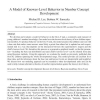Free Online Productivity Tools
i2Speak
i2Symbol
i2OCR
iTex2Img
iWeb2Print
iWeb2Shot
i2Type
iPdf2Split
iPdf2Merge
i2Bopomofo
i2Arabic
i2Style
i2Image
i2PDF
iLatex2Rtf
Sci2ools
87
Voted
COGSCI
2010
2010
A Model of Knower-Level Behavior in Number Concept Development
We develop and evaluate a model of behavior on the Give-N task, a commonly used measure of young children's number knowledge. Our model uses the knower-level theory of how children represent numbers. To produce behavior on the Give-N task, the model assumes that children start out with a base rate that makes some answers more likely a priori than others but is updated on each experimental trial in a way that depends on the interaction between the experimenter's request and the child's knower level. We formalize this process as a generative graphical model, so that the parameters--including the base rate distribution and each child's knower level--can be inferred from data using Bayesian methods. Using this approach, we evaluate the model on previously published data from 82 children spanning the whole developmental range. The model provides an excellent fit to these data, and the inferences about the base rate and knower levels are interpretable and insightful. We ...
Base Rate | COGSCI 2010 | Knower Levels | Model |
Related Content
| Added | 09 Dec 2010 |
| Updated | 09 Dec 2010 |
| Type | Journal |
| Year | 2010 |
| Where | COGSCI |
| Authors | Michael D. Lee, Barbara W. Sarnecka |
Comments (0)

